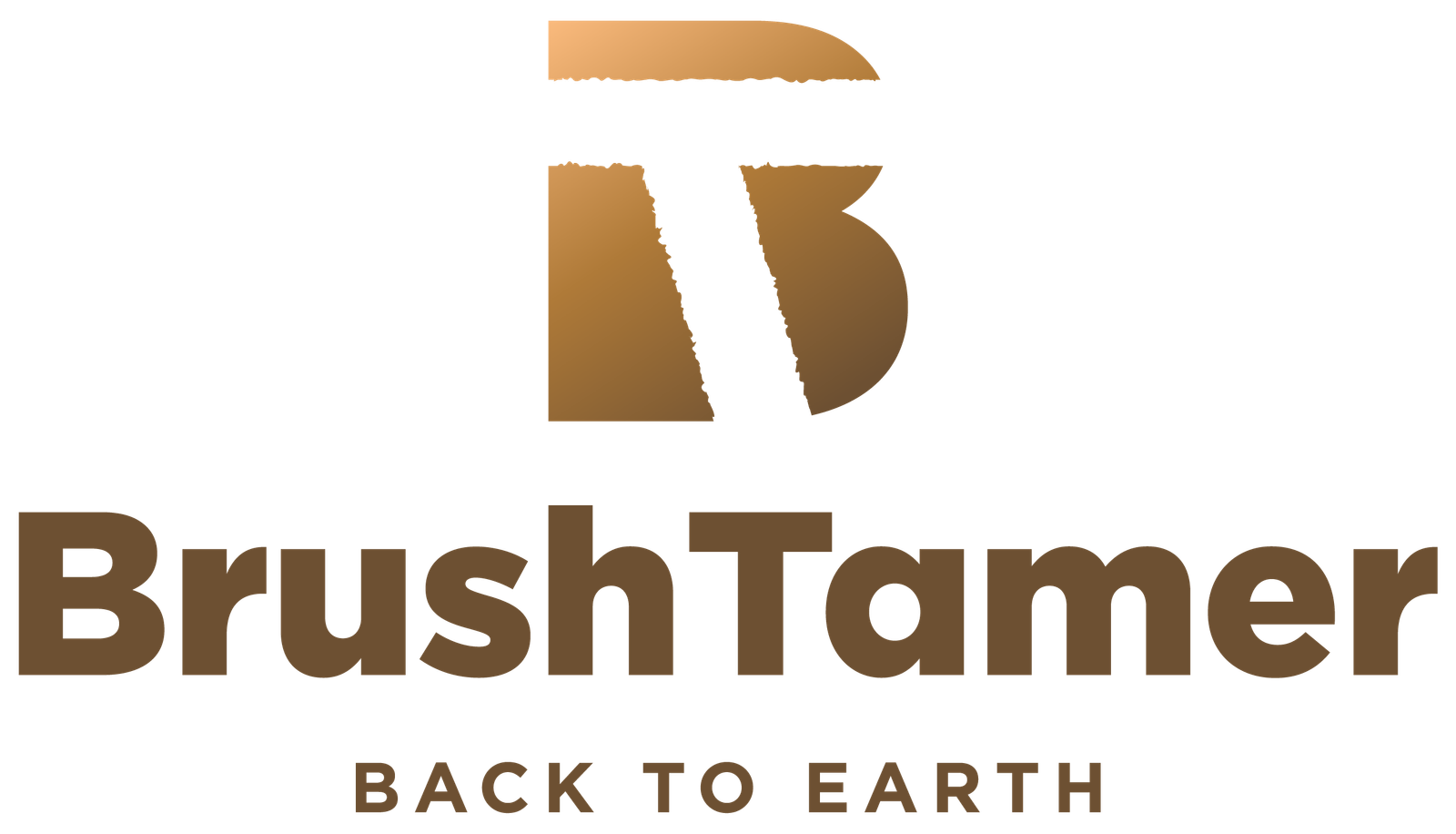Why Vegetation Management Solutions Are More Critical Than Ever
Vegetation management solutions represent a comprehensive and systematic discipline for controlling, inhibiting, or removing unwanted plant growth that poses a threat to critical infrastructure, private and public property, ecological balance, and human safety. These are not merely tree-trimming services; they are sophisticated, data-informed strategies that have undergone a dramatic evolution. What once relied on manual clearing with basic tools has transformed into a high-tech field employing advanced, AI-powered systems capable of predicting and neutralizing risks long before they escalate into emergencies.
The urgency for effective, modern vegetation management cannot be overstated. We are facing a convergence of crises that makes inaction a financially and socially irresponsible choice. Consider the stark numbers: vegetation management expenses grew to an alarming 75% of overhead maintenance budgets in 2020, a staggering increase from 50% in just 2015. This budgetary explosion is happening in parallel with a frightening escalation in system failures. Over the last decade alone, weather-related power outages have increased by a staggering 78%. This creates a perfect storm of skyrocketing operational costs, escalating risks to public safety, and diminishing service reliability that affects millions.
This multifaceted crisis is fueled by several interconnected factors: an aging and shrinking skilled workforce, the increasing frequency and intensity of extreme weather events due to climate change, and the sheer complexity of managing rampant vegetation growth across thousands of miles of utility corridors and critical infrastructure zones. In response, the entire industry is undergoing a fundamental paradigm shift, moving away from inefficient, reactive maintenance schedules toward proactive, data-driven management protocols. Today’s advanced vegetation management solutions do far more than just cut costs—they are an essential tool for preventing catastrophic grid failures, mitigating the ever-present risk of devastating wildfires, and ultimately, protecting the well-being of our communities.
I’m Leon Miller, the owner of BrushTamer. My team and I have dedicated our careers to this field, bringing years of hands-on experience to help property owners, utilities, and municipalities transform overgrown, hazardous land with state-of-the-art vegetation management solutions. We have witnessed firsthand how the right strategic approach, combining cutting-edge technology with ecological expertise, can convert a dangerous liability into a safe, valuable, and resilient asset.
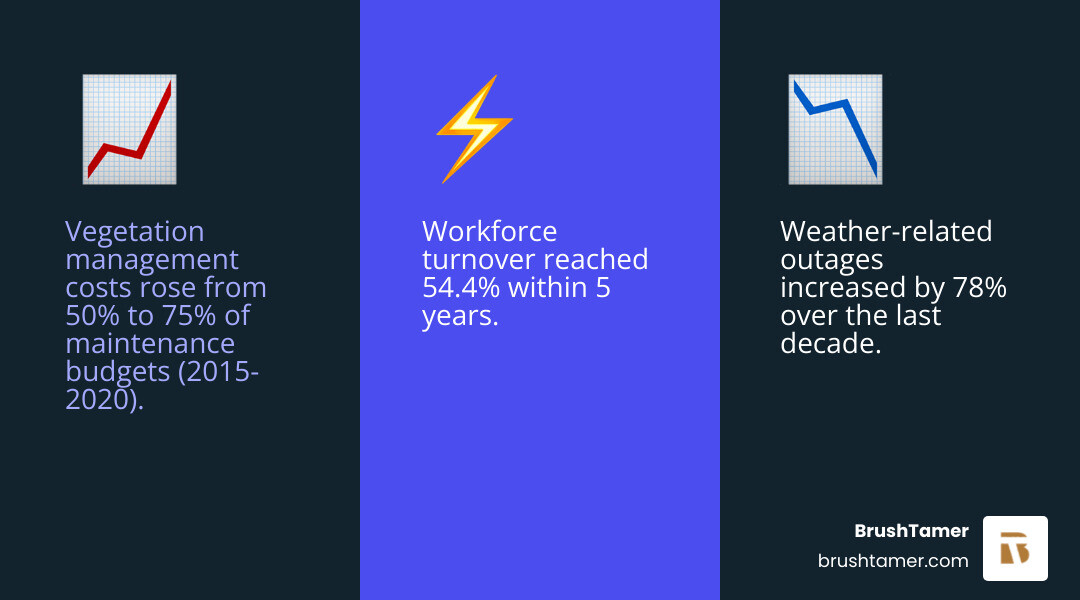
The High Stakes of Overgrowth: Why Unmanaged Vegetation is a Critical Risk
Unmanaged vegetation is not a passive background element; it is one of the most pressing and dynamic threats to our nation’s infrastructure, public safety, and economic stability. The statistics are a clear warning: weather-related power outages have surged by an incredible 78% over the last decade, and a significant portion of these incidents can be directly attributed to unmanaged trees and brush encroaching on critical infrastructure. When vegetation is allowed to grow unchecked, it creates a ticking time bomb, a cascade of potential failures that threatens everything from the stability of our power grids and communication networks to the safety of our homes and transportation routes.
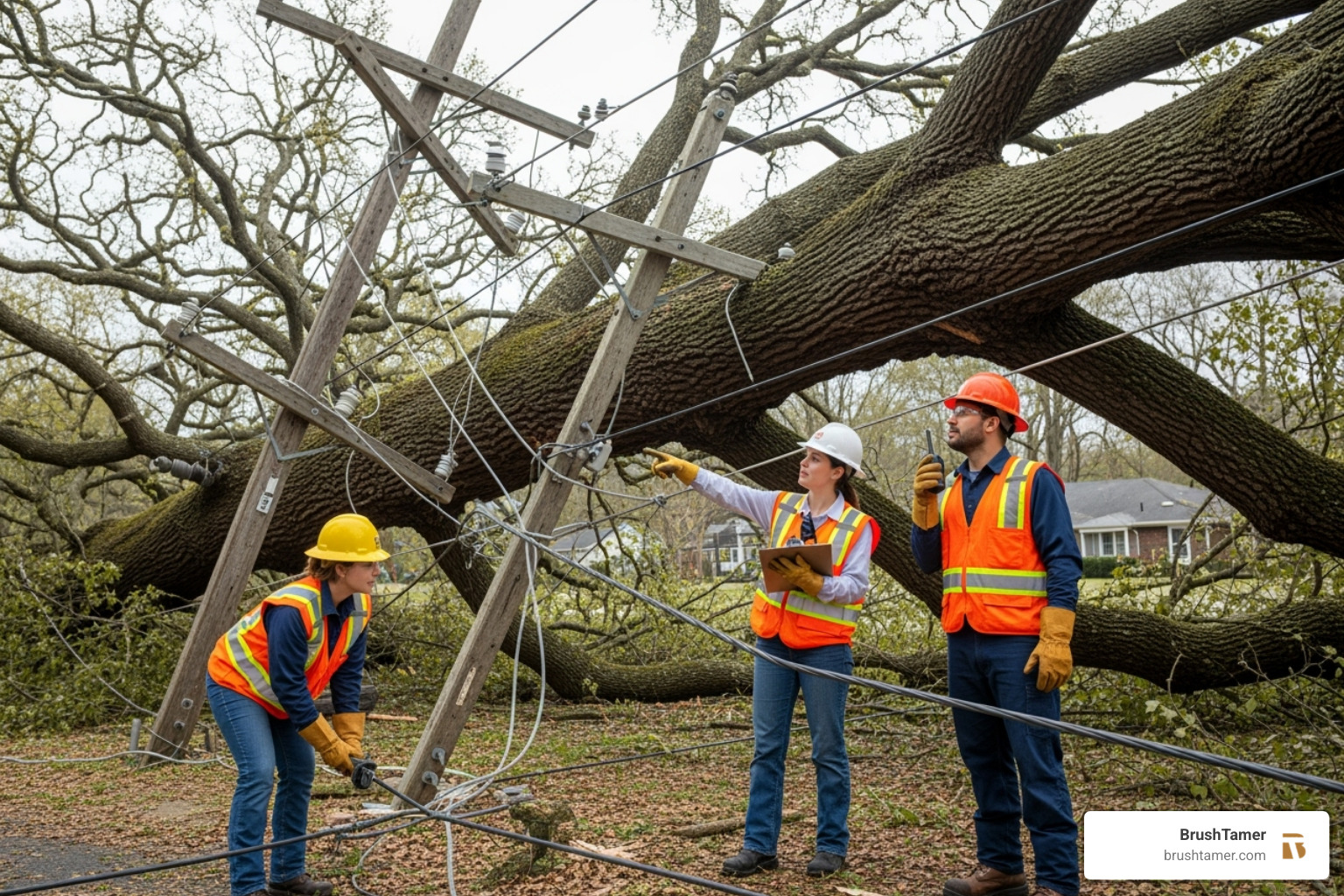
The risks extend far beyond the inconvenience of a power outage. Overgrown vegetation creates significant and often underestimated wildfire ignition risks. Dense, unmanaged brush, dead trees, and dry plant material act as a highly combustible fuel source. This creates “fuel ladders” where a ground fire can quickly climb into the canopies of trees, transforming a manageable blaze into an uncontrollable crown fire. A single spark from a power line swinging in the wind, or a tree branch falling onto a conductor, can ignite a catastrophic inferno, capable of destroying entire communities, devastating businesses, and wiping out invaluable natural habitats in a matter of hours.
Primary Challenges for Utilities and Infrastructure
Utility companies, in particular, are on the front lines of an unending battle against vegetation encroachment. The physics are unforgiving: trees growing too close to high-voltage electrical lines can cause dangerous arcing, where electricity jumps from the line to the tree, leading to fires and service disruptions even without direct physical contact. During storms, these risks multiply exponentially as high winds, heavy rain, or ice accumulation turn tree limbs into powerful projectiles that can snap conductors, damage poles, and destroy expensive equipment like transformers and insulators.
Right-of-Way (ROW) access issues compound these problems significantly. Overgrown vegetation can render access roads impassable, preventing maintenance crews from reaching infrastructure for routine inspections, preventative maintenance, or, most critically, emergency repairs. This directly leads to longer outage durations and drives up operational costs. The financial impact is staggering, with vegetation management now consuming up to 75% of overhead maintenance budgets for many utilities. Furthermore, failure to manage vegetation effectively leads to poor performance on key service reliability metrics like SAIDI (System Average Interruption Duration Index), which can trigger substantial regulatory fines and damage public trust.
Adding a human element to this crisis is an aging workforce, a demographic challenge that threatens the operational capacity of the entire industry. With over half of the skilled workforce having left or retired in the past five years, there is a massive loss of institutional knowledge. This skills shortage makes it impossible to simply hire more people to solve the problem; it forces companies to innovate and adopt modern vegetation management solutions to work smarter, not just harder.
The Limitations of Traditional Vegetation Management
For generations, the standard approach to vegetation management was based on cyclic schedules and manual clearing. This “one-size-fits-all” methodology, often involving trimming every tree along a circuit on a fixed 3-to-5-year cycle, is fundamentally inefficient. It results in crews wasting valuable time and resources clearing slow-growing species in low-risk areas while simultaneously overlooking fast-growing, high-risk trees that could fail long before the next scheduled trim. This purely reactive approach means that managers are always responding to problems that have already developed rather than preventing them from occurring in the first place.
High labor costs and the aforementioned shrinking workforce make these traditional methods financially and logistically unsustainable. The results are often inconsistent, varying wildly based on the skill and judgment of individual crews. Moreover, older methods like broad-spectrum herbicide applications, while effective at killing plants, can have devastating unintended consequences, harming non-target species, contaminating water sources, and damaging the surrounding environment. The industry has reached a breaking point where it must embrace proactive, data-driven vegetation management solutions that can deliver superior results within the constraints of today’s budgets and workforce realities.
From Machetes to Machine Learning: The Evolution of Vegetation Management
The story of vegetation management is a compelling narrative of innovation driven by absolute necessity. What began centuries ago with manual labor—crews wielding machetes, axes, and hand saws to carve paths through the wilderness—has evolved into one of the most technologically sophisticated operations in modern infrastructure maintenance. The first wave of mechanization brought chainsaws and bucket trucks, which increased efficiency but still relied on the same reactive, cycle-based philosophies. The true revolution, however, has occurred in the last decade. This recent shift was not just about improvement; it was about survival for an industry grappling with skyrocketing costs, amplified risks from climate change, and a shrinking pool of skilled labor. Instead of simply trying to work harder, the industry learned to work smarter, harnessing the power of remote sensing, predictive analytics, and artificial intelligence to achieve safer, more effective, and more predictable results.
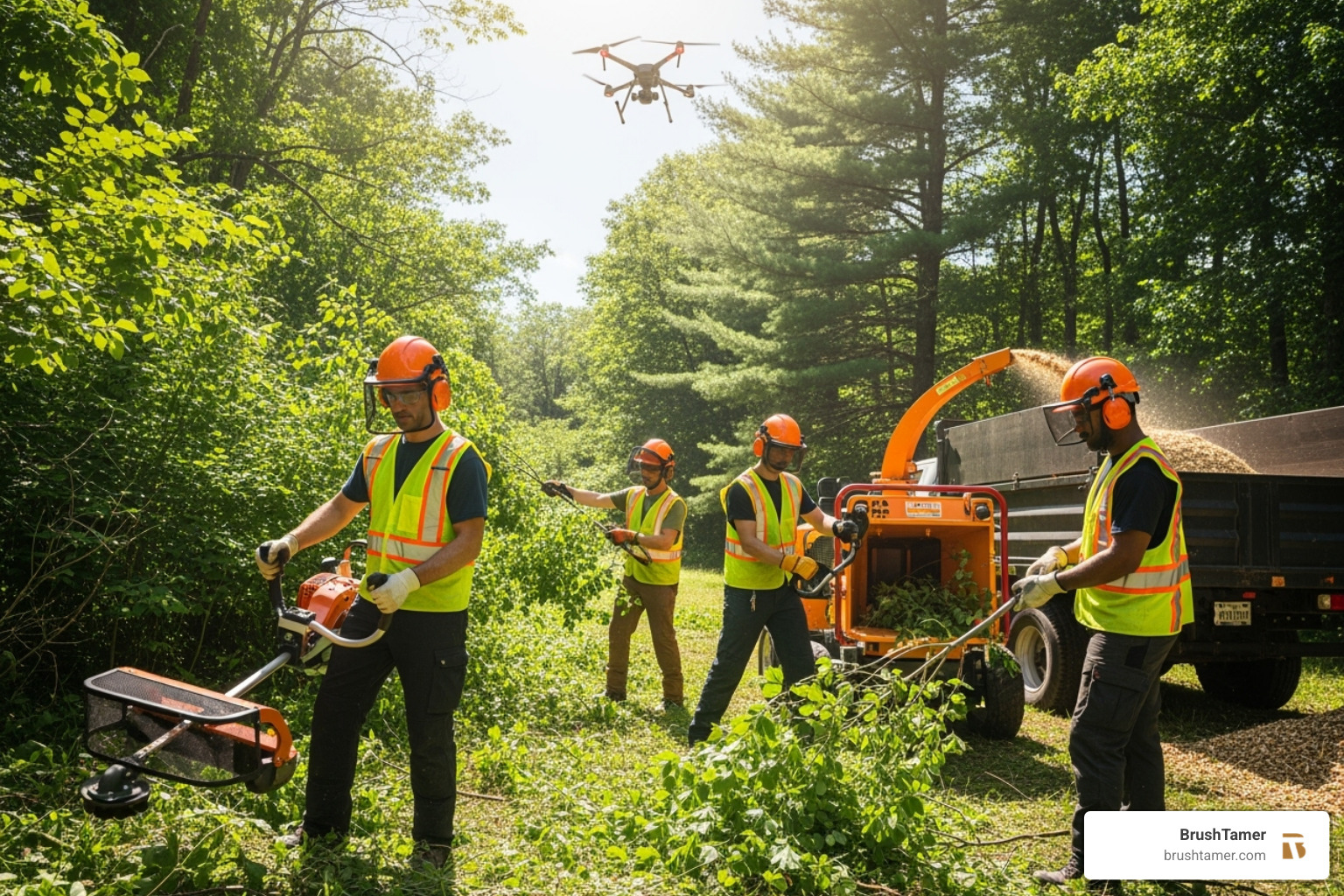
Key Technological Advancements
The technological revolution in vegetation management is fundamentally centered on new and powerful ways of seeing and understanding the environment at scale. Satellite imagery, including multispectral and hyperspectral data, provides a recurring, bird’s-eye view of vast territories. This allows managers to monitor vegetation health over time using indices like NDVI (Normalized Difference Vegetation Index) to spot areas of stress or rapid growth that might indicate a future problem. LiDAR (Light Detection and Ranging) technology takes this a step further. By firing millions of laser pulses from an aircraft or drone, LiDAR creates incredibly detailed 3D point-cloud maps of the terrain and vegetation. This data provides precise measurements of tree height, canopy density, and, most importantly, the exact distance between a tree and a power line, known as tree-to-conductor clearance.
Drones, or Unmanned Aerial Vehicles (UAVs), offer unparalleled flexibility and rapid deployment. They can quickly inspect miles of utility corridors, access rugged or hard-to-reach areas safely, and provide high-resolution imagery and thermal data to detect stressed or diseased vegetation before it becomes a fall risk. The true game-changer, however, is the integration of artificial intelligence and machine learning (AI/ML). AI acts as the powerful brain that processes the immense datasets collected by satellites, LiDAR, and drones. It analyzes this information to automatically identify tree species, predict their future growth rates based on local conditions, and detect subtle signs of disease, decay, or structural weakness that would be invisible to the human eye.
A Closer Look at Modern Vegetation Management Solutions
Today’s most effective vegetation management solutions are guided by the principles of Integrated Vegetation Management (IVM). IVM is not a single technique but a comprehensive, science-based decision-making process. It involves a thoughtful combination of mechanical, chemical, biological, and cultural methods to control unwanted vegetation in a way that achieves specific goals while minimizing environmental impact. The core philosophy of IVM is to move away from a one-size-fits-all treatment and instead diagnose each site individually. This allows us to apply the right combination of techniques to encourage the growth of stable, low-growing plant communities that naturally resist invasion by taller, undesirable species. Our comprehensive Brush Management services are a perfect example of this precise, strategic, and ecologically-minded approach.
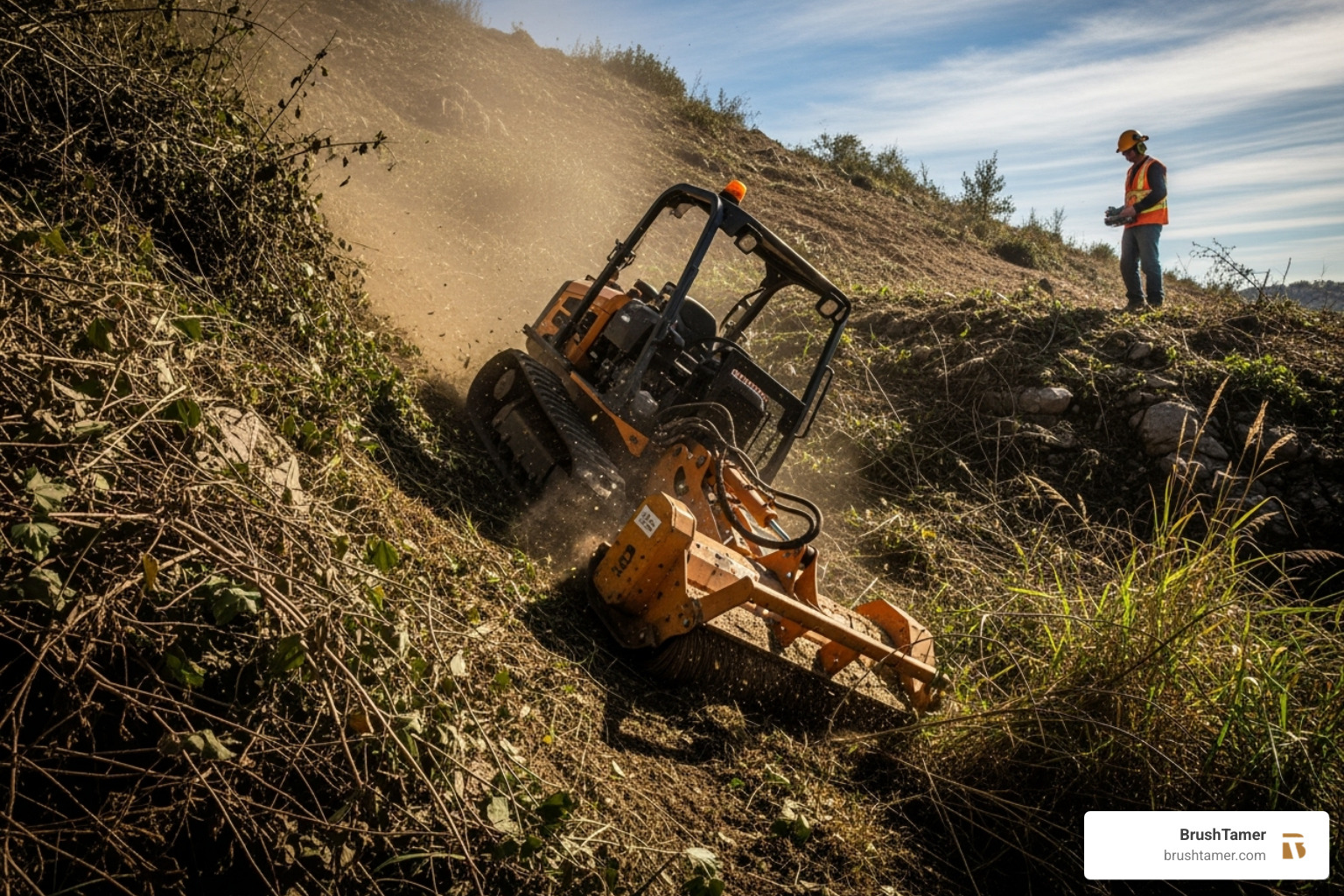
Specialized Equipment and Techniques
Modern vegetation management relies on a fleet of specialized equipment that allows us to work safely, efficiently, and with surgical precision, even in the most challenging conditions.
- Forestry Mulching: Our Forestry Mulching Services utilize powerful machines that simultaneously cut, grind, and shred vegetation, instantly turning it into a nutrient-rich layer of mulch. This process is not only fast but also highly beneficial for the land, as the mulch layer helps prevent soil erosion, retains moisture, and enriches the soil as it decomposes.
- Remote-Operated Machinery: For dangerously steep slopes, unstable ground, or environmentally sensitive areas, these remote-controlled mowers and mulchers are indispensable. They can work on inclines where traditional machinery cannot go, operating up to 10 times faster than a manual crew with chainsaws, all while keeping the human operator at a safe distance.
- Whole Tree Chippers and Feller Bunchers: For large-scale tree removal projects, such as clearing land for new development or creating wide utility corridors, this heavy equipment is essential. Feller bunchers can quickly grab, cut, and stack multiple trees at once, while industrial-grade whole tree chippers reduce them to chips for biomass or landscaping.
- Drones for Herbicide Application: In a paradigm shift for chemical controls, drones can now be used to apply targeted herbicide treatments with incredible precision. This is ideal for treating invasive species in hard-to-reach areas like wetlands or steep ravines, minimizing the amount of chemical used and eliminating collateral damage to non-target plants.
- Stump Grinding: After a tree is removed, the stump remains. Our Stump Grinding & Removal services use specialized machines to grind the stump and its major roots into small chips, eliminating tripping hazards, preventing pest infestations, and leaving a clean, safe, and usable site.
Wildfire Mitigation and Fuel Load Reduction
In an era of increasing wildfire threats, proactive prevention is a critical component of modern vegetation management. Our primary goal is to reduce the fuel load and create defensible spaces. This involves creating defensible space—a buffer zone around structures by thinning and removing flammable vegetation—and constructing fuel breaks, which are wide strips of land cleared of vegetation to slow or stop a fire’s spread. As a safer, more controllable alternative to prescribed burning, we specialize in mastication. This process of grinding vegetation into a protective mulch layer is highly efficient, can be performed in a wider range of weather conditions, and creates “halos of protection” around homes, infrastructure, and entire communities. Our Land Clearing services are designed to restore a more natural, fire-resilient balance to the landscape.
Specific Applications for Modern vegetation management solutions
The versatility of today’s solutions allows us to tailor our approach to a wide variety of needs:
- Solar Power Development: We clear sites for solar farms, ensuring panels receive maximum, unobstructed sun exposure. This includes long-term management plans to prevent regrowth from shading the panels and reducing energy output.
- Construction Site Clearance: We provide a clean, safe, and stable slate for builders, clearing and grubbing the land so that foundation work and heavy machinery operation can proceed without interference.
- Invasive Species Control: We employ specialized techniques to target and eliminate destructive, non-native plants like Japanese knotweed, kudzu, and buckthorn, which can outcompete native flora and destabilize ecosystems.
- Habitat Restoration: By selectively removing overgrown, invasive, or undesirable vegetation, we can help restore native ecosystems like grasslands, savannas, and wetlands, allowing native plants and wildlife to thrive once again.
- Right-of-Way Maintenance: We ensure that vital corridors for roads, railways, gas pipelines, and communication lines remain safe, accessible, and free from hazardous vegetation that could impede access or cause service disruptions.
The Data-Driven Advantage: Quantifying the Benefits and ROI
The paradigm shift to data-driven vegetation management solutions is not just about technological novelty; it delivers tangible, measurable results that directly impact an organization’s bottom line, safety record, and public standing. By leveraging predictive analytics to see exactly where risks are concentrated and when problems are likely to occur, vegetation management transforms from a reactive, unpredictable expense into a strategic, proactive investment. Organizations that have fully embraced these advanced solutions are reporting dramatic and consistent improvements across all key performance metrics, proving the immense value of this modern approach.
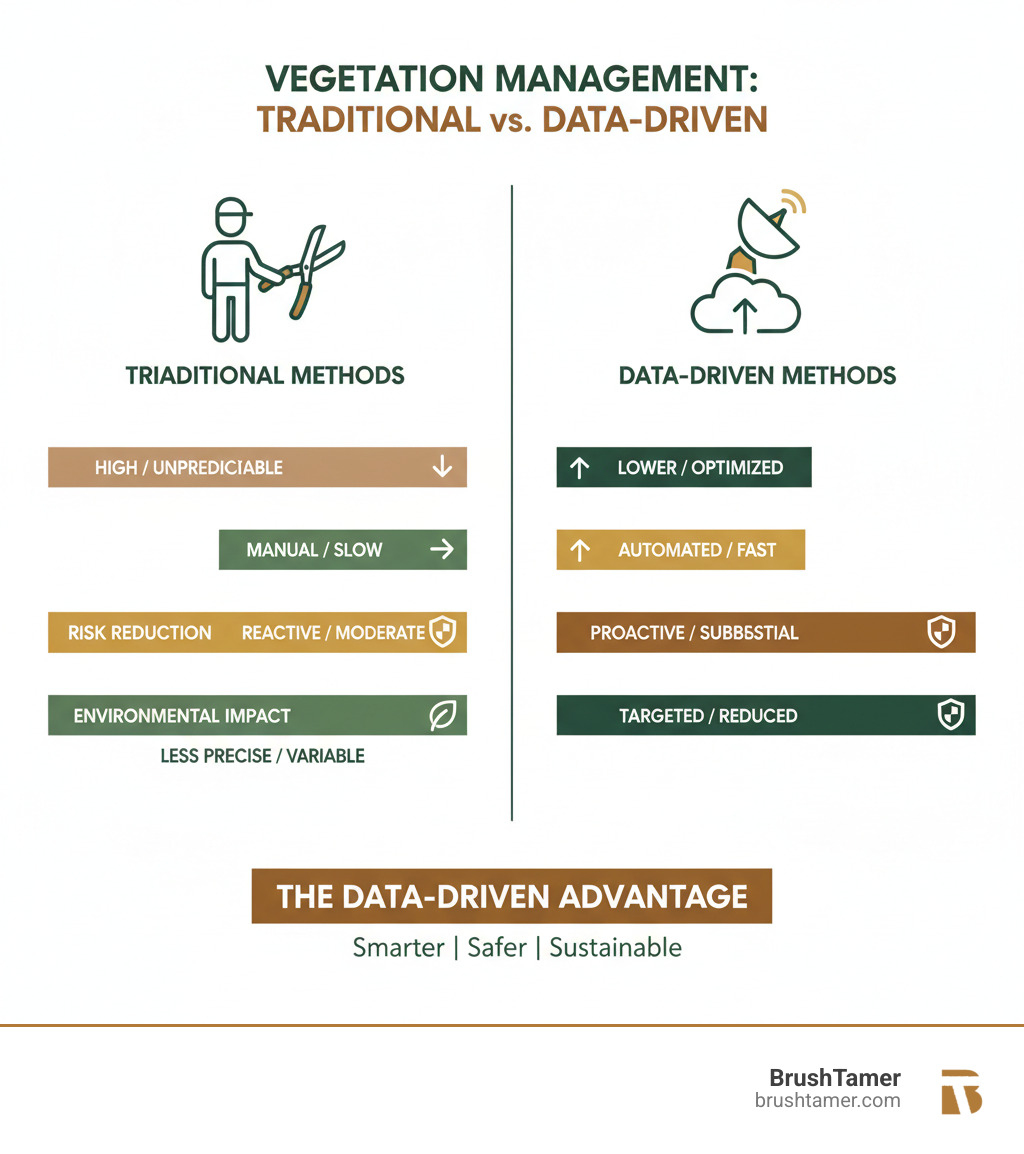
Improving Efficiency and Reliability with advanced vegetation management solutions
One of the most compelling aspects of data-driven solutions is their ability to improve both operational efficiency and system reliability simultaneously, creating a virtuous cycle of continuous improvement.
- Targeted Risk Identification: Resources—both financial and human—are finite. Data-driven models ensure these resources are focused on the specific trees or line sections that pose the highest objective risk, maximizing the impact of every dollar spent and every hour worked.
- Dynamic Cycle Optimization: Moving away from rigid, fixed trim cycles to dynamic, condition-based cycles leads to enormous efficiency gains. This adaptive approach, where trim schedules are dictated by actual growth rates and risk levels, has been shown to produce 46% efficiency improvements in field operations.
- Reduced Customer Interruptions: Proactive management directly translates to a more reliable grid. By preventing tree-related outages before they happen, utilities see a marked decrease in customer interruptions and a corresponding increase in customer satisfaction scores. Some early adopters have even achieved their lowest interruption levels in recorded history after implementing these programs.
- Proactive Storm Response: The strategic value of this data is never more apparent than when a storm is approaching. By overlaying a storm’s predicted path and intensity with the vegetation risk data, managers can identify the most vulnerable areas and proactively dispatch crews to mitigate threats before the storm hits, significantly reducing potential damage and speeding up post-storm restoration.
This data-driven approach creates a new paradigm where vegetation management is no longer a costly burden but a strategic advantage, making operations more effective, predictable, reliable, and resilient.
Choosing Your Strategy: Key Considerations for a Successful Program
Embarking on a successful vegetation management program requires a tailored strategy, not an off-the-shelf product. Finding the right vegetation management solutions is a process of carefully matching the most appropriate techniques and technologies to your specific circumstances. Every property and project is unique, shaped by a distinct combination of terrain, climate, vegetation types, regulatory requirements, and long-term goals. The optimal strategy for a high-voltage utility corridor in a mountainous region will differ vastly from the plan for a new commercial construction site or a solar farm in a flat, arid landscape.
A successful program always begins with a thorough assessment to understand your project goals, terrain challenges (e.g., steep slopes, wetlands), vegetation density and species composition, budgetary constraints, and long-term maintenance objectives. Answering these questions upfront is critical to developing a cost-effective and sustainable plan. Our Professional Land Management services are designed to guide you through this crucial planning phase, ensuring your decisions are informed and confident.
Regulatory Compliance and Environmental Impact
Modern vegetation management solutions must perform a delicate balancing act: achieving maximum effectiveness while demonstrating unwavering responsibility. This means adhering to a complex web of strict regulations while actively protecting and even enhancing the surrounding environment.
- Regulatory Compliance: For utilities, this means strict adherence to mandatory reliability standards like NERC FAC-003, which dictates minimum vegetation clearances for transmission lines. Non-compliance can lead to multi-million dollar fines, as was the case following the 2003 Northeast blackout, which was triggered by tree contact. All chemical applications must also follow federal and state guidelines, including those set by the U.S. Environmental Protection Agency, to ensure safety and proper use.
- Environmental Protection: True stewardship goes beyond mere compliance. We prioritize herbicide footprint reduction by replacing broadcast spraying with highly targeted, selective applications. Our forestry mulching techniques not only clear land but also improve soil health by returning organic matter to the earth. Our Erosion Control Services ensure that cleared areas remain stable and do not pollute nearby waterways. A core principle is the protection of non-target species and sensitive habitats. We also ensure our methods avoid the use of known carcinogens, safeguarding the health of our crews and the public. Our deep commitment to Environmentally Friendly Land Clearing is central to every project we undertake.
Selecting the Right Partner
Choosing the right professional partner is arguably the most critical decision you will make for your project’s success. The expertise and integrity of your provider will directly determine the quality, safety, and cost-effectiveness of the outcome. Look for a provider that demonstrates excellence across several key areas:
- Proven Experience and Regional Expertise: A team that not only has years in the business but also deeply understands the specific challenges of your region, including local microclimates, soil types, and problematic plant species.
- Comprehensive and Modern Equipment: The right tool for every job is not a luxury; it’s a necessity for safety and efficiency. A top-tier partner invests in a well-maintained fleet of modern equipment, from forestry mulchers and remote-operated machinery to the latest survey technology.
- A Strong, Verifiable Safety Record: Safety should be a non-negotiable priority. Ask for their safety metrics, such as their Experience Modification Rate (EMR), and inquire about their training and certification programs.
- Deep Knowledge of Local Ecology: A partner who understands the difference between native and invasive species is essential for projects involving habitat restoration or long-term, sustainable vegetation control.
- A Client-Focused, Transparent Approach: Look for a partner who listens to your goals, communicates clearly and proactively, and provides detailed work plans and progress reports. They should function as a trusted advisor, not just a contractor.
At BrushTamer, we have built our reputation on combining these essential qualities to deliver reliable, high-quality, and environmentally responsible service. Our About Us page shares more about our unwavering commitment to excellence and our role as stewards of the land.
Conclusion
The world of vegetation management has undergone a profound and necessary transformation. What was once a largely manual, reactive, and often inefficient maintenance task has now become a sophisticated, data-driven discipline powered by artificial intelligence, satellite imagery, and advanced precision machinery. This evolution is not merely an upgrade; it is an essential adaptation for staying ahead of the mounting challenges of a changing climate, aging infrastructure, and escalating operational costs.
With vegetation management costs now consuming as much as 75% of maintenance budgets and severe weather-related outages climbing by 78%, the old, cycle-based methods are no longer financially or logistically sustainable. Unmanaged vegetation poses clear and present dangers, from crippling power outages and communication disruptions to catastrophic wildfires that threaten lives and property. Modern vegetation management solutions directly address these issues, turning unpredictable challenges into manageable, data-informed processes by accurately predicting risks and enabling efficient, targeted, and proactive responses.
The financial and operational benefits are clear, compelling, and proven. Organizations are realizing 13x returns on investment and achieving overall cost reductions of up to 40%. Crucially, these data-driven approaches achieve this efficiency while enhancing environmental responsibility. Techniques like forestry mulching improve soil health and prevent erosion, while targeted applications of control methods minimize the impact on the surrounding ecosystem, creating a win-win for both the balance sheet and the environment.
Ultimate success lies in developing a tailored strategy and selecting the right expert partner to execute it. At BrushTamer, we merge decades of field experience with cutting-edge technology and an unwavering commitment to environmental stewardship. We deliver solutions that not only solve your immediate problem but also protect your property, enhance its value, and create sustainable, resilient results for the future.
The future of vegetation management is intelligent, proactive, and here today. It’s time to move beyond reactive maintenance and take strategic control of your landscape. Open up your property’s full potential and ensure its safety and productivity with professional Land Clearing Services. Together, we can build the safe, reliable, and productive landscapes that our communities need and deserve.
